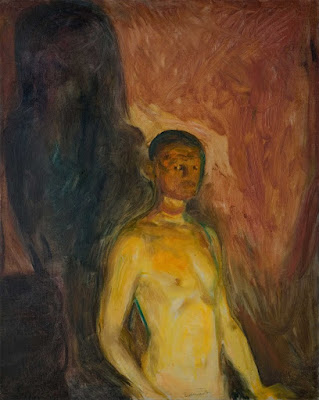Self Portrait in Hell by Edvard Munch (Interpretation and Analysis)
 |
| Self Portrait in Hell Source: Google Arts & Culture |
This tendency in his work is perhaps a reflection of Munch’s own struggles. As a young child, Munch lost both his mother and his favorite sister to tuberculosis, and much of his childhood was overshadowed by grief. Their deaths also caused a lingering sense of sadness and unhappiness in the Munch household that left its mark on young Edvard. Munch also suffered from his own health problems as a child. As an adult, Munch also came to fear that he had inherited madness from his father. Speaking of his own childhood, Munch once said:
The angels of fear, sorrow, and death stood by my side since the day I was born.
He also struggled with drinking, smoking, and had trouble forming relationships with women. So, all and all, Edvard Munch wasn’t a very happy man.
This suffering is reflected in one of his most famous and enigmatic paintings: Self Portrait in Hell. Many art historians have posited that the painting itself is based on a photograph that Munch took of himself standing naked in his garden. Using this image as an artistic jumping-off-point, Munch reshaped his own image to reflect his internal suffering.
In Self Portrait in Hell, Munch likens his spiritual, emotional, and psychological pain to the flames of eternal damnation. Literally. The painting depicts the artist standing naked against a black, red, and yellow background that resembles flames. His face is also shaded red, and a red line marks his neck, suggesting some sort of violence or physical injury.
The piece confronts Munch’s psychological torment head on. The red shading on his face indicates his deep and inescapable pain, his own private hell. The colors inspire a frenetic atmosphere and evoke thoughts of death, doom, and madness. Munch’s unprotected body in the center conveys his own helplessness in the face of this overwhelming situation.
It’s a painting that conveys a lot of vulnerability. Yet, despite the gruesomeness of the scene, the artist stares out at the viewer with a challenging and direct gaze. His expression is haunting, not least because the viewer knows that the artist is aware of his own dire situation. As the Munch Museum in Oslo explains, “He has rather portrayed himself as a dark ruler of his own gloomy kingdom. The flames and smoke might refer to guilt and inner torment, but also to energetic rage.”
This suffering is reflected in one of his most famous and enigmatic paintings: Self Portrait in Hell. Many art historians have posited that the painting itself is based on a photograph that Munch took of himself standing naked in his garden. Using this image as an artistic jumping-off-point, Munch reshaped his own image to reflect his internal suffering.
In Self Portrait in Hell, Munch likens his spiritual, emotional, and psychological pain to the flames of eternal damnation. Literally. The painting depicts the artist standing naked against a black, red, and yellow background that resembles flames. His face is also shaded red, and a red line marks his neck, suggesting some sort of violence or physical injury.
The piece confronts Munch’s psychological torment head on. The red shading on his face indicates his deep and inescapable pain, his own private hell. The colors inspire a frenetic atmosphere and evoke thoughts of death, doom, and madness. Munch’s unprotected body in the center conveys his own helplessness in the face of this overwhelming situation.
It’s a painting that conveys a lot of vulnerability. Yet, despite the gruesomeness of the scene, the artist stares out at the viewer with a challenging and direct gaze. His expression is haunting, not least because the viewer knows that the artist is aware of his own dire situation. As the Munch Museum in Oslo explains, “He has rather portrayed himself as a dark ruler of his own gloomy kingdom. The flames and smoke might refer to guilt and inner torment, but also to energetic rage.”



Comments
Post a Comment